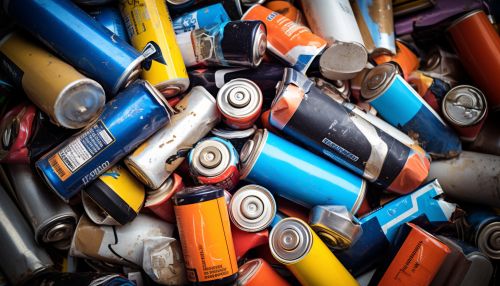Battery Recycling
Introduction
Battery recycling is a recycling activity that aims to reduce the number of batteries being disposed as waste. Batteries contain a number of heavy metals and toxic chemicals and disposing them by the same process as regular waste has raised concerns over soil contamination and water pollution. Batteries can be sorted into chemistries which include lead, nickel-cadmium (NiCd), nickel-metal-hydride (NiMH), lithium ion (Li-ion), and nickel-zinc (NiZn). Each type of battery has its own specific recycling process.


Types of Batteries and their Recycling Processes
Lead Acid
The lead acid battery is the oldest type of rechargeable battery. Despite having a very low energy-to-weight ratio and a low energy-to-volume ratio, its ability to supply high surge currents means that the cells have a relatively large power-to-weight ratio. These features, along with their low cost, make them attractive for use in motor vehicles to provide the high current required by automobile starter motors.
In lead acid battery recycling, the used batteries are crushed into small pieces and heated in a furnace where lead and heavy materials fall to the bottom and plastic floats. At this point, the polypropylene pieces are scooped away and the liquids are drawn off, leaving the lead and heavy metals. Each of the materials goes into a different recycling stream.
Nickel-Cadmium
Nickel-Cadmium (NiCd) batteries are rechargeable and are used in a wide range of applications from toys and consumer electronics to aerospace and military equipment. They are known for their long life, high discharge rate and robustness.
NiCd battery recycling involves a high-temperature metal reclamation (HTMR) method to recover valuable metals. The batteries are shredded and placed into a kiln where they are heated to high temperatures. The metals are then separated and recovered.
Nickel-Metal-Hydride
Nickel-Metal-Hydride (NiMH) batteries are similar to NiCd batteries but have a hydrogen-absorbing alloy for the negative electrode instead of cadmium. They are used in hybrid electric vehicles, portable electronics, and other devices.
NiMH battery recycling involves a process known as pyrometallurgical recovery. The batteries are shredded and placed into a furnace where the nickel and other metals are recovered.
Lithium Ion
Lithium Ion (Li-ion) batteries are common in home electronics. They are one of the most popular types of rechargeable batteries for portable electronics, with a high energy density, no memory effect, and only a slow loss of charge when not in use.
Li-ion battery recycling involves a process known as hydrometallurgical recovery. The batteries are shredded and placed into a vat of acid where the metals are dissolved. The metals are then precipitated from the solution and recovered.
Nickel-Zinc
Nickel-Zinc (NiZn) batteries have a high energy density and long cycle life, making them an ideal choice for high drain devices. They are used in a variety of applications including electric vehicles, power tools, and medical equipment.
NiZn battery recycling involves a process known as hydrometallurgical recovery. The batteries are shredded and placed into a vat of acid where the metals are dissolved. The metals are then precipitated from the solution and recovered.
Environmental Impact
Battery recycling has significant environmental benefits. It reduces the demand for raw materials, decreases the amount of waste going to landfill, and reduces the risk of soil and water pollution. By recycling batteries, we can conserve natural resources, reduce greenhouse gas emissions, and prevent pollution.
Legislation and Regulation
In many countries, battery recycling is mandated by law. In the European Union, for instance, the Battery Directive regulates the manufacture and disposal of batteries in EU member states with the aim of improving the environmental performance of batteries and accumulators. In the United States, the Battery Act regulates the manufacture, disposal, and recycling of batteries.
